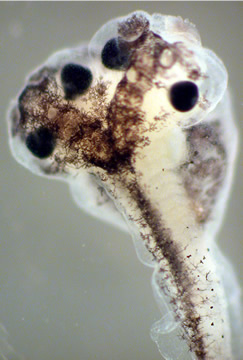| updated
20-Jan-2010 |

|
 |
|
You will need:gonadotropin from pregnant mare serum (PMS) (Calbiochem)
PMSG is dissolved in sterile water to make 2500 U/ml and then further diluted 1:10 with Ca2+, Mg2+ free Ringers, resulting in a concentration of 250 U/ml. |
|
|
| 1X MMR Dilute this stock 1:5 or 1:3 to make 20% and 33% MRS solutions. |
Testes
buffer: 2% Cysteine: |
Holtfreter's solution: 1 liter 3.5 g NaCl 0.05 g KCl 0.1 g CaCl2 0.2 g MgSO4 7H20 0.2 g NaHCO3 |
| Ficoll (400,000 molecular weight, dialyzed and lyophilized; Sigma Cat. No. F1418) Human Chorionic Gonadotropin (HCG) (Sigma, Cat. No. CG-5) Gonadotropin from pregnant mare serum (PMSG) (Calbiochem, Cat. No. 367222) L- Cysteine (Sigma, Cat. No. C7880) Benzocaine (Ethyl p-Aminobenzoate; Sigma Cat. No. E1501) Fetal Calf Serum (Calf Serum Bovine; Sigma Cat. No. C6278) Gentamicin Sulfate (Sigma Cat. No. G3632) |
| |
| |
| Egg Activation and Inversion Experiments For prick activation experiments, dejellied eggs were positioned in small wells made in agarose plates (2% type V high gelling temp., in 1x Ringers). They were pricked quickly using a micromanipulator with a clean glass needle while held in a solution of 5% Ficoll in 20% Ringers. Inversion experiments were done in the same Ficoll solution. Dejellied fertilized eggs were inverted gently with forceps 180° and held in wells on agarose plates. Inversions were complete by 30' post-fertilization, and embryos were left to develop upside down throughout the experiment. The calcium ionophore A23187 was used for ionophore activation. Dejellied eggs were placed in a solution of 10mg/ml A23187 supplemented with fetal calf serum. Activation was confirmed by observing the slow contraction of the animal pigment cap at approx. 10'-15' post-fertilization and the upward rotation of the animal hemisphere. Eggs were transferred to 20% Ringers to develop for the remainder of the experiment. |
|
Injection Plates Oocytes and eggs are injected in 5% ficoll in 100% Ringers. After injection, oocytes are transferred to normal, ficoll-less media. Embryos are transferred to 5% ficoll in 20% Ringers. Embryos should be transferred to 20% Ringers between stages 5-6. Miscellaneous |
| Natural Mating: You can have a natural mating to raise tadpoles if you are interested in expanding your colony. To do this you must inject both the male and the female. You should inject the male with 50 U HCG(or 50 U PMS) and inject the non-PMS primed female with 750 U HCG. Put them in a 5 gallon bucket together and allow them to remain together overnight. You should do this at the end of the day so the lab will be quiet throughout the night and the frogs are not disturbed. If possible place egg crate at the bottom of the tank to keep the frogs away from the eggs. This will prevent the eggs from being eaten before you separate the couple. The next day, collect the eggs by sucking them up in a pipette and placing them in 10% Holtfreter's solution. We've had the best luck when we dejelly the eggs with 2% Cysteine and then keep them in 10% Holtfreter to which Gentamicin Sulfate (80mg/liter) has been added. Tadpole care: Keep tadpoles at room temperature in 10% Holtfreters. Replace solution once per day and feed with 'Tadpole Slurry' in the morning. I add a teaspoon of the slurry for every 500 ml. 100% Tadpole Slurry: To make 100 ml of slurry, add 1 tablespoon of Spirulina power and 1 teaspoon of Brewer's Yeast, mix and keep at 4C. |
| |